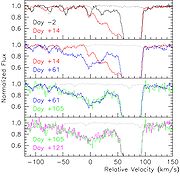
SN 2006X
Encyclopedia
SN 2006X was a Type Ia
supernova
about 65 million
light-year
s away in Messier 100
, a spiral galaxy
in the constellation
Coma Berenices
. The supernova was independently discovered in early February 2006 by Shoji Suzuki of Japan
and Marco Migliardi of Italy
.
SN 2006X is particularly significant because it is a Type Ia supernova. These supernovae are used for measuring distances, so observations of these supernovae in nearby galaxies are needed for calibration. Fortunately, SN 2006X is located in a well-studied galaxy, and it was discovered two weeks before its peak brightness, so it may be extraordinarily useful for understanding supernovae and for calibrating supernovae for distance measurements. It may even be possible to identify the progenitor of this supernova.

Type Ia supernova
A Type Ia supernova is a sub-category of supernovae, which in turn are a sub-category of cataclysmic variable stars, that results from the violent explosion of a white dwarf star. A white dwarf is the remnant of a star that has completed its normal life cycle and has ceased nuclear fusion...
supernova
Supernova
A supernova is a stellar explosion that is more energetic than a nova. It is pronounced with the plural supernovae or supernovas. Supernovae are extremely luminous and cause a burst of radiation that often briefly outshines an entire galaxy, before fading from view over several weeks or months...
about 65 million
1 E22 m
To help compare different orders of magnitude, this page lists distances starting at 10 Zm .Distances shorter than 10 Zm* 24 Zm — 2.5 million light years — Distance to the Andromeda Galaxy...
light-year
Light-year
A light-year, also light year or lightyear is a unit of length, equal to just under 10 trillion kilometres...
s away in Messier 100
Messier 100
Messier 100 is an example of a grand design spiral galaxy located within the southern part of constellation Coma Berenices. It is one of the brightest galaxies in the Virgo cluster, approximately 55 million light-years distant from Earth and has a diameter of 160,000 light years...
, a spiral galaxy
Spiral galaxy
A spiral galaxy is a certain kind of galaxy originally described by Edwin Hubble in his 1936 work The Realm of the Nebulae and, as such, forms part of the Hubble sequence. Spiral galaxies consist of a flat, rotating disk containing stars, gas and dust, and a central concentration of stars known as...
in the constellation
Constellation
In modern astronomy, a constellation is an internationally defined area of the celestial sphere. These areas are grouped around asterisms, patterns formed by prominent stars within apparent proximity to one another on Earth's night sky....
Coma Berenices
Coma Berenices
Coma Berenices is a traditional asterism that has since been defined as one of the 88 modern constellations. It is located near Leo, to which it formerly belonged, and accommodates the North Galactic Pole...
. The supernova was independently discovered in early February 2006 by Shoji Suzuki of Japan
Japan
Japan is an island nation in East Asia. Located in the Pacific Ocean, it lies to the east of the Sea of Japan, China, North Korea, South Korea and Russia, stretching from the Sea of Okhotsk in the north to the East China Sea and Taiwan in the south...
and Marco Migliardi of Italy
Italy
Italy , officially the Italian Republic languages]] under the European Charter for Regional or Minority Languages. In each of these, Italy's official name is as follows:;;;;;;;;), is a unitary parliamentary republic in South-Central Europe. To the north it borders France, Switzerland, Austria and...
.
SN 2006X is particularly significant because it is a Type Ia supernova. These supernovae are used for measuring distances, so observations of these supernovae in nearby galaxies are needed for calibration. Fortunately, SN 2006X is located in a well-studied galaxy, and it was discovered two weeks before its peak brightness, so it may be extraordinarily useful for understanding supernovae and for calibrating supernovae for distance measurements. It may even be possible to identify the progenitor of this supernova.


